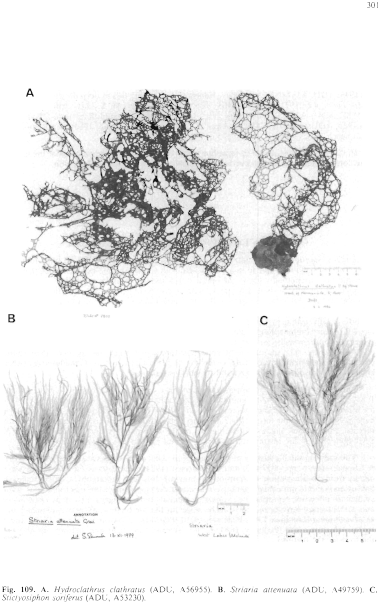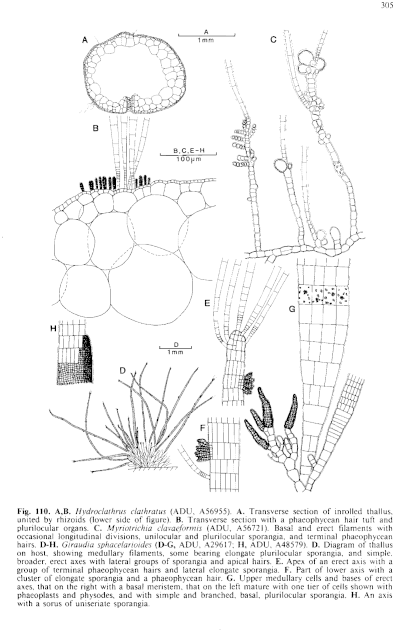|
|
|
|
|
|||||||||||
|
Electronic Flora of South Australia Genus Fact Sheet
Phylum Phaeophyta – Order Scytosiphonales – Family Scytosiphonaceae
Thallus irregularly globular, convolute or spreading, 5–20 (–100) cm across, 3–10 (–20) cm high, hollow with a clathrate membrane with holes of various sizes and irregularly placed, often becoming torn and sheet-like with age, with a broad, vague, attachment. Growth diffuse. Structure of membrane with a medulla of large, clear cells and a small-celled cortex 1–3 cells thick, cells with a single phaeoplast and pyrenoid. Phaeophycean hairs in scattered groups, becoming sunk in cavities.
Thallus (Fig. 109A) medium to dark brown, (5–) 10–25 (–35) cm across and 3–15 cm high, at first globular to pulvinate, hollow, and soon becoming clathrate, when larger becoming irregularly lobed and often torn with an expanded, clathrate, membrane; holes variable in size and arrangement, round to ovoid, 2 mm-2 (–4) cm across, with the membrane 1–4 mm broad, with a broad, diffuse, rhizoidal attachment, epilithic or epiphytic. Structure (Fig. 110A,B) of membrane with an inner, large-celled medulla 3–5 (–6) cells thick, and a small-celled cortex 1 (–2) cells thick, often with the margins inrolled (Fig. 110A) and becoming attached by short rhizoidal extensions from the cortical cells, thus forming elongate vesicles with the medulla and cortex all around; surface cortical cells isodiametric, 6–10 µm across, each with a single phaeoplast and pyrenoid; phaeophycean hairs in groups, scattered, 12–15 µm in diameter.
Reproduction: Reproduction by plurilocular organs in surface sori, extending generally over the thallus.
Sori of plurilocular reproductive organs (Fig. 110B) usually present on young thalli, extending over the outer surface of the net with remnants present on older thalli, surrounding or accompanied by hair groups; plurilocular organs uniseriate or biseriate, 15–20 µm and 3–5 locules long, 4–5 µm in diameter, with 2–4 rows corresponding to each cortical cell; paraphyses absent.
Life history. Probably direct (Clayton 1982, p. 114).
Type: Type species: H. cancellatus Bory [= H. clathratus (C. Agardh) Howe].
Lectotype from Belle Isle, France (but see Hamel 1937, p. 202); in Herb. Bornet, PC; Herb. Agardh, LD?
Selected specimens: Strickland Bay, Rottnest Aust., 0–1.5 m deep (Engler & Clarke, 5.ix.1979; ADU, A51103). Israelite Bay, W. Aust., drift (Wells, 10.xii.1974; ADU, A46078). Pearson I., S. Aust., 20–25 m deep (Shepherd, 8.i.1969; ADU, A33858). Elliston, S. Aust., lower eulittoral inside Bay ( Womersley, 9.i.1976; ADU, A46761-"Marine Algae of southern Australia" No. 170). Fishery Bay, S.W. of Port Lincoln, S. Aust., lower eulittoral on Hormosira (Bailey, 20.viii.1967; ADU, A31854). Emu Bay, Kangaroo I., S. Aust., drift (Womersley, 10.i.1946; ADU, A3374). Vivonne Bay, Kangaroo I., S. Aust., 0–5 m deep on jetty piles (Kraft & Min Thein, 4.xii.1971; ADU, A41403). 10 km S. of Normanville, S. Aust., drift ( Womersley, 9.ii.1986; ADU, A56955). Port Fairy, Vic., in sheltered upper sublittoral pool (Womersley, 15.x.1985; ADU, A56991-"Marine Algae of southern Australia" No. 170a). San Remo, Vic., ocean beach, drift (Sinkora A1931, 27.xi.1974; ADU, A53464).
Distribution: Widely distributed in tropical to temperate waters.
In Australia, all around the mainland coast but not in Tasmania, from just above low tide level to 25 m deep.
Taxonomic notes: A genus of two species, the widely distributed type species and H. tenuis Tseng & Lu (1983).
Hydroclathrus clathratus (C. Agardh) Howe 1920: 590. Johnson & Dromgoole 1977: 269, figs 1–4. Lindauer et al. 1961: 262. Taylor 1960: 261, pl. 36 fig. 5. Womersley 1967: 245.
H. cancellatus Bory. Boergesen 1914: 177, fig. 139. Harvey 1859a: p1 98.
H. clathratus is distinctive in form but varies considerably in compactness of the net, the more compact forms usually occurring in shallow water with more wave action.
References:
BOERGESEN, F. (1914). The marine algae of the Danish West Indies. Vol. 1, Part 2. Phaeophyceae. Dansk bot. Ark. 2, 157–226.
BORY DE ST-VINCENT, J.B. (1825a). Hydroclathre. Dict. Class. d'Hist. Nat. 8, 419.
CLAYTON, M.N. (1982). Life history studies in the Ectocarpales (Phaeophyta): Contributions toward the understanding of evolutionary processes. Bot. Mar. 25, 111–116.
HAMEL, G. (1937). Phéophycées de France. Fasc. III, pp. 177–240. (Paris.)
HARVEY, W.H. (1859a). Phycologia Australica. Vol. 2, Plates 61–120. (Reeve: London.)
HOWE, M.A. (1920). Algae. In Britton, N.L. & Millspaugh, C.F., The Bahama Flora. (New York.)
JOHNSON, K.A. & DROMGOOLE, F.I. (1977). Occurrence of Hydroclathrus clathratus in northern New Zealand waters. N.Z. J. Mar. Freshw. Res. 11, 269–272.
LINDAUER, V.W., CHAPMAN, V.J. & AIKEN, M. (1961). The marine algae of New Zealand. II. Phaeophyceae. Nova Hedwigia 3, 129–350, Plates 57–97.
TAYLOR, W.R. (1960). Marine algae of the eastern tropical and subtropical coasts of the Americas. (Univ. Mich. Press: Ann Arbor.)
TSENG, C.K. & LU, B. (1983). Two new brown algae from the Xisha Islands, South China Sea. Chin. J. Ocean. Limn. 1, 185–188, Plate I.
WOMERSLEY, H.B.S. (1967). A critical survey of the marine algae of southern Australia. II. Phaeophyta. Aust. J. Bot. 15, 189–270.
The Marine Benthic Flora of Southern Australia Part II complete list of references.
Publication:
Womersley, H.B.S. (14 December, 1987)
The Marine Benthic Flora of Southern Australia
Part II
©Board of the Botanic Gardens and State Herbarium, Government of South Australia
Illustrations in Womersley Part II, 1997: FIGS 109A, 110A,B.

Figure 109 enlarge
Fig. 109. A. Hydroclathrus clathratus (ADU, A56955). B. Striaria attenuata (ADU, A49759). C. Stictyosiphon soriferus (ADU, A53230).

Figure 110 enlarge
Fig. 110. A,B. Hydroclathrus clathratus (ADU, A56955). A. Transverse section of inrolled thallus, united by rhizoids (lower side of figure). B. Transverse section with a phaeophycean hair tuft and plurilocular organs. C. Myriotrichia clavaefortnis (ADU, A56721). Basal and erect filaments with occasional longitudinal divisions, unilocular and plurilocular sporangia, and terminal phaeophycean hairs. D–H. Giraudia sphacelarioides (D–G, ADU, A29617; H, ADU, A48579). D. Diagram of thallus on host, showing medullary filaments, some bearing elongate plurilocular sporangia, and simple, broader, erect axes with lateral groups of sporangia and apical hairs. E. Apex of an erect axis with a group of terminal phaeophycean hairs and lateral elongate sporangia. F. Part of lower axis with a cluster of elongate sporangia and a phaeophycean hair. G. Upper medullary cells and bases of erect axes, that on the right with a basal meristem, that on the left mature with one tier of cells shown with phaeoplasts and physodes, and with simple and branched, basal, plurilocular sporangia. H. An axis with a sorus of uniseriate sporangia.

|
Email Contact: State Herbarium of South Australia |

|